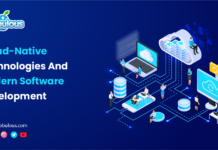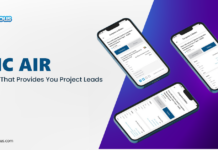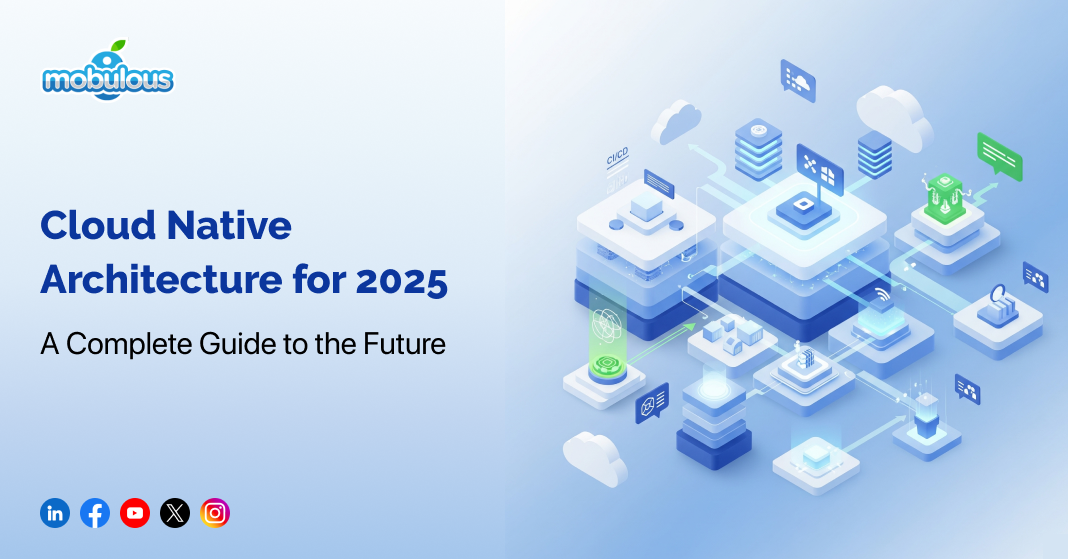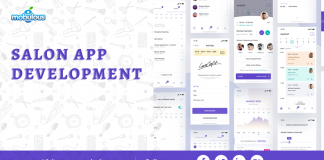What is Cloud Native Architecture?
Cloud native architecture is a way of building applications designed specifically for the cloud, and it’s not just about moving apps to the cloud, but it’s about reshaping them to take full advantage of it. These apps are made up of small, independent services, and these services can be deployed and scaled on their own.
Each part of a cloud native system works independently, which means teams can update features without affecting the whole app. It makes releasing updates quicker and reduces downtime. This architecture relies on tools like microservices and containers. They make it easier to build flexible and powerful systems in the cloud.
Cloud native systems also focus on automation and scalability. They use CI/CD pipelines and orchestration tools. These tools help developers push updates faster. They also reduce the need for manual work, which leads to more consistent results and better efficiency across development and operations.
Principles of Cloud Native Architecture
1. Designing for Resilience
Resilience is a key principle of cloud native architecture. Systems must be able to detect failures automatically. They should recover without human help. Even if one part breaks, the rest of the system keeps running to ensure users experience minimal downtime and smooth performance.
2. Automation Everywhere
Automation is essential for speed and consistency. From building code to deploying updates, everything is automated to reduce human error and speed up workflows. It also ensures that the same process is followed every time to make development more reliable and easier to manage.
3. Stateless Services
Cloud native systems often use stateless services. These services don’t save data between requests. Each request is handled on its own, which makes it easier to scale up or down. It also helps distribute workloads evenly. As a result, performance stays stable during heavy traffic.
4. Focus on Observability
Observability means knowing what’s happening inside your system. Cloud native apps use monitoring, logging, and tracing tools. These tools help track performance and find problems. Teams can spot issues early and fix them before users are affected. It keeps systems healthy and reliable.
To learn more about how cloud computing is reshaping mobile app development, check out our blog, The Impact of Cloud Computing on Mobile App Development Companies.
Components of Cloud Native Architecture
1. Microservices
Microservices are small services that handle specific tasks. They work independently and communicate through APIs. If one fails, others keep running, making systems more stable and easier to manage. Developers can build and deploy microservices separately. This speeds up releases and encourages flexibility.
2. Containers
Containers bundle an app and all its dependencies together to make the app run the same everywhere. Tools like Docker and Kubernetes manage containers at scale. Containers are lightweight and fast. They help teams deploy apps quickly and avoid conflicts between environments.
3. Immutable Infrastructure
With immutable infrastructure, servers are never changed after setup. Instead of updating live systems, new ones are deployed to avoid configuration errors and make rollbacks easier. It also keeps systems secure and predictable. Every change is made through new builds, not patches.
4. Service Meshes
Service meshes handle how services talk to each other. They offer load balancing, encryption, and traffic control without changing the app code. Service meshes improve security and performance. They also give better insights into system behavior.
5. Declarative APIs
Declarative APIs describe what a system should look like, not how to build it. Kubernetes uses this approach. It reads your desired state and keeps the system in sync to make configuration easier. It also helps ensure consistency across environments.
6. CI/CD Pipelines
CI/CD stands for continuous integration and continuous delivery. These pipelines automate testing and deployment. Developers push code faster and with fewer bugs. CI/CD helps teams release new features more often. It also ensures updates are tested before going live.
7. Automation
Automation runs throughout cloud native systems. It handles provisioning, scaling, updates, and monitoring to reduce the need for manual work. It also improves reliability and speed. Automated systems adjust to traffic, fix issues, and deploy new code efficiently.
A web app development company ensures your cloud-native apps are scalable, resilient, and optimized for high performance in today’s dynamic environment.
How Cloud Native Architecture is Different
Cloud native architecture is built for the cloud, whereas traditional systems are not. Older apps are often large and hard to update, which is why they can’t scale easily. Cloud native apps are modular and built for speed, as they’re made to grow, adapt, and recover.
Microservices in cloud native are a key difference. Instead of one big app, cloud native systems have many small parts. Each can be deployed and managed on its own, making it easier to roll out updates and fix bugs. The system stays online while changes happen.
Automation is built into cloud native. Traditional systems rely on manual tasks. Cloud native apps use tools to automate everything, including deployment, scaling, and monitoring. It speeds up work and reduces human error. Teams can do more with less effort.
Cloud native systems handle failures smartly. In legacy systems, one failure might crash the app. Cloud native systems isolate problems. If one part fails, others keep going, making the system more reliable. It also improves the user experience.
Why Cloud Native Architecture in 2025?
Cloud native architecture is critical in 2025. It helps businesses adapt to fast-changing demands. With this model, apps can scale instantly and recover from failures by keeping services online and customers happy. It also supports continuous updates and innovation.
More companies are going digital. Cloud native architecture supports this shift by enabling teams to build and deploy apps that scale with the business. The flexibility helps companies stay competitive. It also improves time to market for new features.
Cost savings are another big reason. Cloud native tools use resources efficiently. They scale only when needed to avoid waste and reduce cloud bills. Businesses can focus their spending where it matters. That’s a huge win in a tight economy.
Security and compliance are easier with automation. Infrastructure as code and policy-based tools enforce standards to keep systems secure. It also helps meet regulatory needs. In a world with growing cyber threats, that’s a major advantage.
To stay competitive in 2025, migrate seamlessly with cloud migration and hosting company expertise, enabling you to fully embrace cloud-native architecture.
Pros of Cloud Native Architecture
Cloud native architecture offers modern solutions for modern problems. It helps businesses move faster and adapt quicker. Let’s look at the biggest benefits.
1. Agility and Speed
Teams can push updates faster. With microservices, each part of an app can be improved without affecting the rest, leading to more frequent releases. Developers no longer wait for full-cycle rollouts as changes go live quickly. Customers benefit from constant improvements and bug fixes. It’s a huge boost for innovation and user experience.
2. Scalability
Cloud native systems grow with your needs. If demand spikes, they scale up automatically. During quiet hours, they scale down to save costs to ensure performance remains stable. You don’t need to over-provision resources. Whether it’s ten users or ten million, the system adjusts. Your app stays smooth and responsive at all times.
3. Cost-Effectiveness
You only pay for what you use. There’s no need for heavy hardware or physical servers. Since the system scales up and down, resources are never wasted. Cloud providers handle the infrastructure to cut down maintenance and staffing costs. Startups and enterprises alike benefit from more efficient budgeting and leaner operations.
4. Improved Resilience
Cloud native systems handle failure gracefully. If one part fails, the rest keep working. Microservices are independent, stopping one error from crashing the whole app. Systems restart services automatically. Built-in redundancy keeps uptime high. Businesses experience fewer outages. Customers enjoy more reliable services, even when issues occur in the background.
5. Better Resource Utilization
Cloud native architecture uses resources smartly. Containers share systems without interfering. Orchestration tools assign workloads to the best place. Unused resources are released automatically. There’s no clutter or idle power drain. Every CPU cycle counts, which leads to better performance and lower bills. It’s a win-win for developers and finance teams.
Cons of Cloud Native Architecture
Despite the benefits, cloud native architecture isn’t perfect. It brings some serious challenges. Here’s what to watch out for.
1. Increased Complexity
Breaking an app into microservices means more pieces to manage. Each service has its own dependencies. Monitoring all of them requires tools and expertise. Debugging issues becomes harder, and it’s easy to get overwhelmed. Teams need strong coordination. Without the right setup, complexity can slow things down rather than speed them up.
2. Vendor Lock-in
Using unique cloud services ties you to that provider, and switching becomes hard later. Migration takes time, money, and effort. Features from one provider might not work on another. Businesses must weigh speed vs. flexibility. A short-term win may lead to long-term limitations. Planning ahead can prevent painful transitions down the road.
3. Dependence on Network Connectivity
Cloud native systems often run behind abstractions. Teams can’t always see the exact machine behavior that makes debugging harder. Tools can help, but they add another layer. Problems can go unnoticed until they’re big. Gaining deep insights requires setup and monitoring. Transparency isn’t built-in, but it’s something teams must actively build.
4. Security Risks
More services mean more entry points for attacks. A single misconfigured container can expose data. APIs must be secured properly. Encryption, identity, and access rules are crucial. Without strong security practices, vulnerabilities multiply. Keeping everything patched and locked down is harder. The speed of deployment should never compromise safety.
5. Specialized Skill Requirements
Cloud native tools are new to many developers. Learning Kubernetes, containers, and service meshes takes time. The learning curve is steep, and hiring experienced engineers is tough and costly. Training in-house staff requires commitment. Without the right skills, mistakes happen. Companies must invest in education or risk poor implementation and inefficiencies.
Cloud Native Architecture Trends in 2025
The future of cloud native is here. In 2025, it’s evolving faster than ever. New trends are shaping how teams build and scale apps.
1. Multi-Cloud and Hybrid Strategies
Companies no longer rely on just one provider. They use multiple clouds to improve flexibility. Some mix public and private clouds for better control to avoid vendor lock-in. It also improves uptime and resilience. Smart workloads move where they run best. It’s about choosing the right cloud for each task.
2. AI and Machine Learning Integration
Artificial intelligence helps run the cloud smartly. It predicts problems before they happen. It adjusts resources automatically. AI can even detect security threats in real time. Developers save time by automating routine tasks. Systems become self-healing. With AI, cloud native environments are faster, safer, and more reliable than ever before.
3. Serverless Computing
Developers love writing code without managing servers. Serverless functions scale instantly. You only pay when your code runs. Maintenance is minimal, and deployment is fast. In 2025, more companies are embracing serverless. It’s perfect for short tasks, background jobs, and rapid experiments. Simpler development leads to faster innovation cycles.
4. Edge Computing
Data is processed closer to where it’s created to reduce lag and save bandwidth. Think of smart cities, self-driving cars, or real-time sensors. These systems need instant responses. Edge computing delivers that speed. Cloud native architecture now supports apps that run at the edge. It’s critical for next-gen experiences.
5. Sustainable Cloud Practices
Sustainability matters more in 2025. Companies seek greener ways to use the cloud. They reduce waste, optimize workloads, and choose energy-efficient providers. Some track carbon use in real time. Others deploy only during low-energy hours. Cloud native architecture plays a key role. It supports better resource planning and cleaner computing.
Leverage the power of AI and ML with an AI/ML development company, optimizing your cloud-native systems for smarter, faster, and more secure performance.
Real-World Uses of Cloud Native Architecture
Cloud native architecture powers everyday apps and services. Many industries are using it to solve real problems and grow faster.
1. E-commerce Platforms
Online stores face massive traffic during sales. Cloud native systems scale automatically. No downtime, even with thousands of users, which improves customer experience. Cart abandonment drops, revenue rises, and brands gain loyalty through reliability. That’s why top retailers choose cloud native for their backend systems.
2. Streaming Services
Millions watch videos at once. Cloud native helps distribute the load. Services are deployed globally for low-latency streaming. Updates roll out with no downtime. Users get better quality with less buffering. Platforms like these rely on resilient systems. Cloud native makes it possible to deliver smooth streaming to any device.
3. Financial Institutions
Financial apps need speed and security. Cloud native lets teams push updates often. New features launch without service interruptions. Services stay up, even during maintenance. Banks gain a competitive edge. They improve mobile experiences and backend efficiency. Security remains strong thanks to layered protection across microservices.
4. Healthcare Applications
Cloud native architecture supports scalable telehealth. It ensures high uptime for appointment systems. Patient data is encrypted and stored safely. Apps can handle growing user demand. Hospitals and clinics update features without affecting care. It’s about speed, safety, and better service. The result? More responsive and accessible healthcare.
5. Gaming Industry
Gamers expect zero lag. Cloud native helps studios deliver that. Servers scale with player demand, updates push without downtime, and crashes recover quickly. Multiplayer games stay stable even at launch. Fast deployment cycles keep content fresh. Players stay engaged, and companies stay ahead in a crowded market.
Best Practices of Cloud Native Architecture
Want to succeed with cloud native in 2025? Follow these proven strategies. They’ll help your apps stay fast, flexible, and reliable.
For a deeper dive into the technologies powering modern cloud-native systems, check out our blog: Cloud-Native Technologies And Modern Software Development.
1. Adopting Microservices
Don’t build a massive app; instead, split it into small, single-purpose services. Each one runs independently, so you can update them without touching others. It’s easier to test, debug, and scale, which reduces risk. Teams can work on different features at the same time. Development moves faster and with less downtime.
2. Utilizing Containers
Containers are light and portable. They package everything an app needs, and you can run them anywhere. From local dev machines to the cloud, they behave the same, which reduces bugs. Containers also make deployments quicker. Teams spend less time fixing environment issues and more time writing better software.
3. Automating with CI/CD Pipelines
Continuous integration and deployment streamline development. Code is tested automatically, builds are created without manual work, and deployments happen with a push, which reduces errors. Teams catch bugs early, features roll out faster, and automation makes the pipeline smoother. Developers focus on code, not delivery, ensuring speed and quality both go up.
4. Implementing Infrastructure as Code (IaC)
Write your infrastructure like code. Tools like Terraform or CloudFormation do just that. You get version control, repeatability, and easier rollback. It’s faster than clicking around dashboards. IaC ensures your setup is consistent across environments. You avoid surprises during deployment. Changes are tracked and reviewed just like application code.
5. Monitoring and Observability
Failure happens all the time, so plan for it. Use retries, circuit breakers, and backups. Cloud native systems should continue running even if one part fails. Build health checks and fallback services. Monitor performance constantly, and don’t wait for users to report issues. Create systems that recover quickly and learn from each failure.
Tools for Cloud Native Architecture
Cloud native architecture depends on tools. These tools simplify development, deployment, and management. Let’s break down the essentials.
1. Docker and Containerd
Docker helps build and run containers, as it bundles code with dependencies. Containerd runs those containers efficiently, as it’s fast and lightweight. Together, they ensure consistent environments to reduce bugs caused by mismatched software. They support fast launches and updates. Developers love them for their speed and simplicity.
2. Kubernetes
Kubernetes manages containers at scale. It deploys them, monitors them, and restarts them when they fail. It also balances workloads. Teams don’t need to handle these tasks manually. It’s the engine behind large-scale cloud native apps. Kubernetes ensures uptime, smooth scaling, and smarter resource use.
3. Istio and Linkerd (Service Meshes)
These tools manage communication between microservices. They control traffic, enforce security, and track performance. You don’t need to change your code. They add reliability and visibility. Think of them as managers for all service-to-service chats. Your system becomes safer and more stable with them.
4. CI/CD Pipelines
These platforms automate code testing and deployment. Developers push code, and the tools test, build, and deploy it. No need to do things by hand, saving time and reducing errors. They also support rollbacks if something breaks. CI/CD pipelines make delivery faster, safer, and more predictable.
5. Prometheus, Grafana, Jaeger
Prometheus collects metrics. Grafana visualizes them in beautiful dashboards. Jaeger traces how requests move through your app. Together, they show what’s working and what’s not. You get real-time insight into performance. These tools help spot problems early. They are essential for healthy, cloud native systems.
6. Terraform and CloudFormation (IaC)
With these tools, you define infrastructure in code. Terraform works across clouds, and CloudFormation is for AWS. They make the setup and updates repeatable. No more guesswork or manual errors. Infrastructure becomes easy to manage and track. Teams move faster and with more confidence using IaC.
Conclusion
Cloud native architecture is the foundation of modern tech in 2025. It brings speed, resilience, and flexibility to every industry. But it comes with challenges too. Complexity, security, and skills gaps can slow you down. Still, with the right tools and best practices, the benefits far outweigh the hurdles. Embracing cloud native now prepares your business for the future.
The future is cloud-first, automated, and agile. Companies that choose cloud native now will lead tomorrow. Whether you’re a small startup or a large business, cloud native helps you grow. It also helps you stay efficient. Most of all, it helps you stay competitive.
Start building for the future today.
FAQs – Cloud Native Architecture
Q1. What is cloud native architecture?
A cloud native architecture is a way of designing applications specifically for the cloud. It uses technologies like microservices, containers, and automation to build apps that are scalable, flexible, and resilient. Instead of running on one big server, the app is split into smaller parts that can grow or shrink as needed.
Q2. What are the three principles of cloud native architecture?
The three main principles of cloud native architecture are microservices, containerization, and dynamic orchestration. These help developers build systems that are easy to scale, update, and manage. Each part of the app runs independently, so if one piece needs to change or grow, it can do so without affecting everything else.
Q3. What is cloud native, with an example?
Cloud native means building and running apps to fully use cloud computing’s features. For example, Netflix is a cloud native company that uses microservices and tools like Docker and Kubernetes to handle millions of users at once. This approach helps them stay fast, flexible, and always available.
Q4. What is a cloud native pattern?
A cloud native pattern is a ready-made solution to common problems when building apps for the cloud. These patterns help developers create systems that are easy to scale, resilient to failure, and quick to update. They often involve breaking apps into smaller services that can run, grow, or be fixed independently.
Q5. Is Kubernetes cloud native?
Yes, Kubernetes is a cloud native platform. It helps manage containerized applications by automating tasks like deployment, scaling, and recovery. Kubernetes is a key tool in cloud native development because it makes it easier to run apps reliably across different cloud environments without needing to manage everything manually.
Q6. What is the difference between cloud and cloud native?
Cloud refers to using computing services over the internet, like storage or servers. Cloud native, on the other hand, is a way of building apps specifically to run well in the cloud. It uses modern tools like containers and microservices to make apps more flexible, faster to update, and easier to manage.
Q7. What are the pillars of cloud native development?
The pillars of cloud native development are microservices, containers, DevOps, and continuous delivery. These elements work together to make app development faster and more reliable. They help teams build apps that are easy to scale, quick to release, and able to recover quickly if something goes wrong.
Q8. Why use cloud native?
You should use cloud native to build apps that are flexible, scalable, and quick to update. It helps businesses save money, move faster, and stay competitive by using modern cloud technologies. With cloud native, your apps can handle high traffic, recover from issues easily, and roll out new features more quickly.
Q9. Is Azure cloud native?
Yes, Azure is a cloud native platform. It provides all the tools and services needed to build, deploy, and manage cloud native apps. Developers can use Azure to take full advantage of the cloud’s flexibility and scale, helping them create powerful applications that work smoothly and grow with demand.
Q10. What is a cloud native tool?
A cloud native tool is software made to work in cloud environments. It helps developers build, run, and manage apps that are scalable and resilient. Examples include Kubernetes, Docker, and Terraform. These tools are designed to take full advantage of cloud features like automation, flexibility, and on-demand scaling.
































